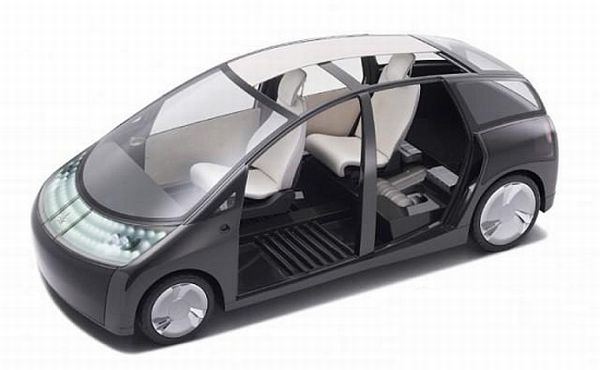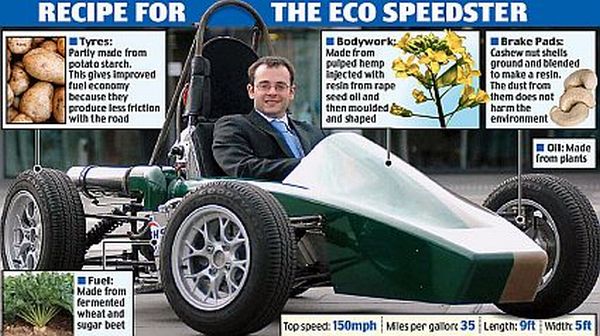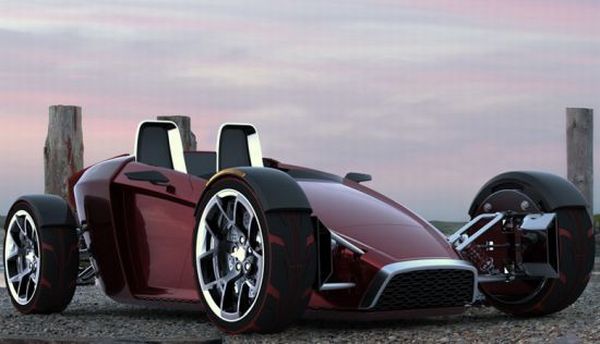
What’s happening right now?
Previously we had talked about how transportation infrastructure has always been a major part of our modern economy. And as with other important industries how it does consume massive quantities of energy as well as emanates high levels of carbon emissions. Well, this is where the green vehicles come into the picture, literally as the zero emission saviors of our eminent automotive industry. Now green cars can be categorized by their fuel efficiency, mode or even manufacturer, but green cars composed from sustainable, green materials should certainly be classified as a distinct class altogether. They seem to be the only vehicles to imbibe that unique essence of total sustainability with their entire propensity.
Trends:
1. Toyota develops hybrid car made of seaweed!:

Yes you have read that correctly and it may seem baffling, but it is very true. Named as the 1/X, this hybrid car concept will be composed of derivatives of seaweed fused with carbon-fiber reinforced plastic for body strength. To be endowed with a 500cc engine, the car will be a smaller cousin to the Prius (the engine being about 1/3 of its size) with a weight of just over 400kg.
2. Ford’s green hybrids get sustainable interiors:

In a righteous bid to lower our carbon dioxide emissions by a whopping 5 million pounds, Ford has ingeniously come up with natural soya-based cushion foam for their car seats, which would also be draped in recyclable fabric. This in effect nullifies the usage of conventional polyurethane foam derived from non renewable petroleum. The ambitious plan entails that around a million cars are to be furnished with such ‘naturalistic’ seats. And as a side note Ford is looking forth to adopt other sustainable elements like bio-plastics and bio-resins for their car components.
3. A high-performance green car, 95% biodegradable:

Researchers form Warwick University has adroitly conceived this fascinating piece of contraption, and in our experience it becomes the closest thing to being described as ‘nature on wheels’. The vehicle has tires made of potatoes, brake pads from ground cashew shells, body from hemp and rapeseed oil; and if that was not enough it uses fuel made from fermented wheat and sugar beet! And wait, don’t be fooled by all those ‘crops’, here is the good part; the car can actually spurt to a high speed of 150mph and has a mileage of 35mpg.
4. Sunbeam Tiger Concept – a complete green ride for the future:

Okay this one’s a little on the conventional side, but the design elements remain as remarkably practical as ever. The main chassis is composed of recycled aluminium with integrated rollover protection for the user, while the body panels are made from hemp fiber and are eco-painted as well. And it’s not only about the looks, notching a ‘green’ level up, soya foam cushions have been introduced onto the seats, and too covered in all natural bio-fabric.
5. Toyota hybrids to get green interiors with plant-based resin:

Green is literally about to become green if this conscientious proposition by Toyota ever comes to be realized. After gifting the world Prius (and that too 2 millions of it!), Toyota now plans to incorporate a newly developed plant-based resin that could be used to cover 60 percent of the interior. Maybe recycled carbon fiber on the outside and sustainable elements in the inside; now that would be our type of car.
The concept:
Green technology is advancing at such a fast and rather unique rate that we can simply co-relate it to evolving. The automotive industry has done its fair share of polluting, and in a bid to rectify that they have adopted the low emission ideal over the last decade. And now rather ascending to a much higher level they (at least some sections of the industry) are trying to endorse that ultimate dictum of energy saving and efficiency, in relation to the whole procedure, not just the sustainable end product i.e. the green vehicle.
The advantages:
As already mentioned, low emissions deal with just the end product i.e. the car itself, while adoption of green materials certainly imparts sustainability to the whole production procedure, culminating in the final design. Hence adoption of green materials in green cars logically allows for low fossil fuel consumption as well as reduced emissions. Moreover from an economic point of view cost effectiveness is an important criterion, and green cars can conveniently make that positive difference in fuel efficiency, in comparison to their gas guzzling cousins.
The impact:
A proper definition of a green vehicle suggests that it is a road motor vehicle that produces less harmful impacts to the environment than comparable conventional internal combustion engine vehicles running on gasoline or diesel, or one that uses alternative fuels. But here we are dealing with green vehicles made out of green materials, and it certainly counts more than that. The clear and rather righteous distinction in this case would be the holistic approach to sustainability. Vehicles emanating low emissions are good, but vehicles made out of sustainable elements and emitting low emissions are certainly better. Now if we equate that with their affordability, the ‘green’ impact could truly be manifold in this case.




